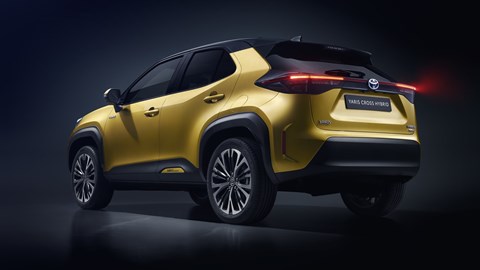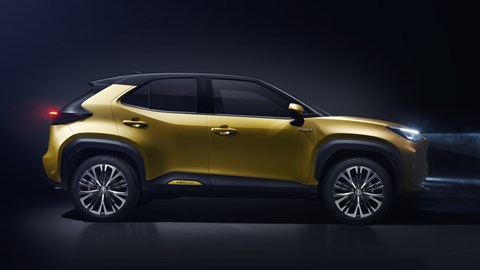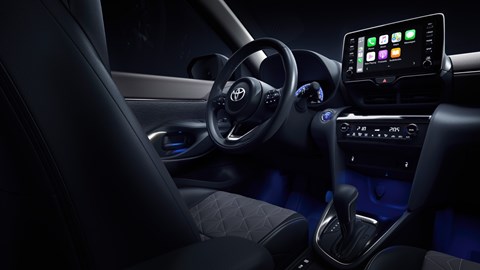► Toyota’s first B-segment SUV
► Sits below C-HR and RAV4
► To go on sale in 2021
Toyota has unveiled its new compact SUV. Named the Yaris Cross, it’s a car that’s going to have to take the fight to the likes of the Nissan Juke, VW T-Cross, Peugeot 2008 and Renault Captur – duking it out in what’s probably Europe’s most crowded and challenging marketplace.
Revealed today via virtual press conference (in place of a physical event, due to the Covid-19 pandemic) the new SUV will go on sale in 2021.
Why do I care about another cookie-cutter compact SUV?
You should care because it’s based on the new Yaris, an all-new car compared to its predecessor and one that was very promising based on our early drive impressions. It also rides on the same scalable TNGA platformas the Yaris in GA-B configuration, with sweet-driving larger SUVs like the C-HR and RAV4 using the GA-C platform.

You should also care because Toyota expects thousands of people to buy one – 150,000 sales in the first year in Europe – and it’s predicting that the new Yaris family of hatch, GR and Yaris Cross will make up a third of its sales volume. You’re likely to see a lot of these cars on the roads.
That’s not all, while Toyota is trumpeting this as Euro-designed and Euro-built (it’s made in France, alongside the Yaris) it’ll be a global model.
Fine. So, first impressions?
It’s unmistakeably descended from the Yaris in the styling department, but with RAV4 influence – to be expected, really. It rides on an identical 2,560mm wheelbase to the hatchback but is 240mm longer, 90mm higher and 20mm wider to make for a more spacious interior.
The cheapest hybrid cars to buy
A downturned grille has the Toyota badge sitting proud atop it, and is flanked by swept-back LED headlights. There’s the same two-tone roof, which gives the illusion of a rising C-pillar at the rear – and across the back there’s a glossy black panel connecting the taillights.

But, since this is an SUV, it’s a little taller, with black plastic cladding around squared-off wheelarches and rather more beef in its stance. Though the grille does have somewhat of the gummy grandpa about it, the rest of the car really isn’t bad-looking – it’s striking and wears brighter colours well, much like the Yaris and C-HR.
Any big selling points?
Two major ones. Firstly, it’s a hybrid – definitely a good buzzword to get people interested. Like the Yaris, it’s of the self-charging variety, so there’ll be no charging up or standalone all-electric journeys, but that should help make it simpler, lighter, and cheaper.
It’s also available with all-wheel drive, which is a real rarity among cars in this sector, using an e-motor within the hybrid powertrain to drive the rear wheels. It’s badged identically to the RAV4, as ‘intelligent’, or i-AWD. All-wheel drive models also feature multilink rear suspension, as opposed to the torsion beam of the front-driven versions.
Not one for any true mud-plugging, then, but given that all-wheel-drive compact SUVs are limited to the Dacia Duster, Mitsubishi ASX, Hyundai Kona and Suzuki Vitara, Toyota could be on to a winner for buyers who insist on having two driven axles.
Tell me more about that hybrid system
It’s the same as in the Yaris – a 1.5-litre system developed directly from the 2.0 and 2.5-litre hybrids in the C-HR and RAV4 respectively. That means a 1.5-litre, three-cylinder petrol engine running the Atikinson cycle, paired up to an electric motor.
Best hybrid cars and plug-ins
Total system output is 114bhp, marginally less powerful than the Yaris but in line with entry-level models of most competitors such as the Juke, 2008 et al.
Efficiency is what Toyota really goes for, though, and while fuel economy figures haven’t been announced it expects CO2 to be below 90g/km NEDC or 120g/km WLTP for front-wheel drive models.
As for any other engine variants, Toyota is still deciding where to offer a non-hybrid alternative version in certain European countries. We suspect the UK may go hybrid-only.
What about inside?
An identical dashboard to the Yaris, with the same infotainment screen set proudly high-up on the centre console, with climate controls below. Again, from our first impressions of the Yaris cabin, this is a massive improvement over the outgoing model, with sturdy materials and a straightforward layout – but it does look mighty dark in there, and a Renault Captur will undoubtedly be a nicer place to spend time in.
Practicality, a hallmark of the compact SUV, hasn’t been forgotten. A powered tailgate reveals a flexible boot, with a two-level floor and retaining straps to stop items rolling about. Toyota’s also fitted a highly useful 40:20:40 split rear seat, which is much more flexible than the usual 60:40 split. Toyota engineers told CAR there would be a slight sacrifice in boot space for the all-wheel drive version due to the placement of the rear e-motor.

Interior kit and tech levels haven’t been properly announced, but all models will get the latest Toyota Safety Sense driver assistance pack bringing driver information and warnings plus autonomous emergency braking and lane-keep assist where necessary.
When can I buy one?
European sales commence in 2021 – nothing more precise than that was offered, presumably due to the uncertainty of the ongoing Covid-19 outbreak that may yet impact the Yaris’ planned sale date of September 2020.
Pricing and full spec details will be announced closer to launch.